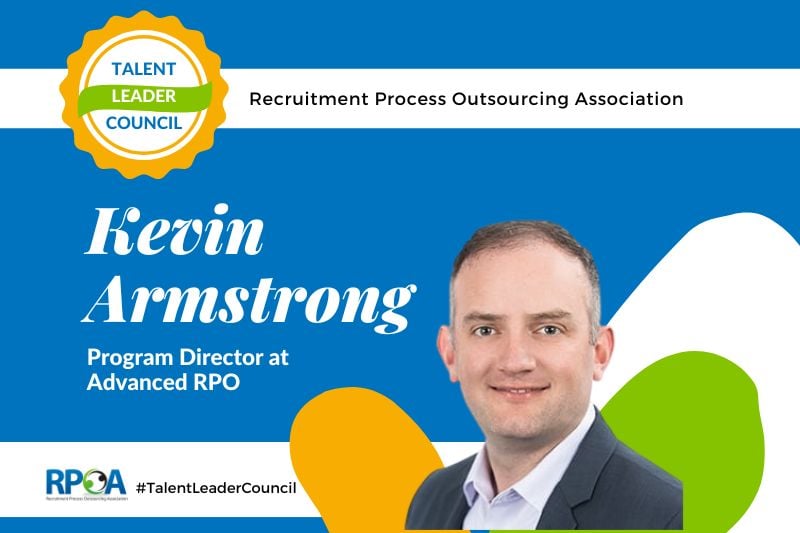
New recruitment technology has rapidly changed recruitment. With streamlined processes and AI adoption, recruiters can more easily find qualified candidates. Industry leader Kevin Armstrong, Program Director at Advanced RPO, provides valuable insights on the latest labor market analysis trends, technology optimization, and AI adoption.
In a recent interview with Talent Leader Council Program Director Lamees Abourahma, Armstrong highlighted the importance of data-driven labor market research and integrating new tools like AI to enhance the recruitment process. He also predicts a wider adoption of AI in recruitment due to time pressures and talent shortages. The following is an edited version of the interview.
RPOA: How has labor market analysis changed for companies in the last 5-10 years?
Armstrong: The need for labor market analysis has increased significantly in the last 5-10 years. Labor markets have been changing faster than ever, with increased mobility among workers and rapidly changing salaries and hourly rates across geographies and job levels. Using outdated benchmarking data that is more than a year or two old to set salary expectations can make it difficult for recruiters and lead to missing the right talent. RPO providers like Advanced RPO have access to more current data on labor market trends that can help companies make more informed hiring decisions from the start of a search. Regular labor market analysis is vital for aligning strategies with current supply and demand dynamics.
Q: Can you provide some examples of recent labor market trends you've seen?
Armstrong: For hourly, non-exempt roles over the last two years, I’ve seen compensation stabilize after rapid increases where pay might quickly jump from $12 to $20 per hour. Now, the focus is shifting back to other job factors like number of shifts, benefits, and company reputation. Understanding local competition is also crucial, as strategies differ depending on whether the main competitors are large Fortune 500 companies or smaller operations. Geographical differences in cost of living have also become more pronounced, with some rural areas now more expensive than cities in some instances.
Q: How has the rise of remote jobs affected hiring in your client's industries?
Armstrong: Due to their nature, remote jobs have not been as prevalent for the hourly roles I work with; however, across client bases, remote and hybrid work arrangements have become more accepted following the shift during the pandemic. Many roles, like sales, have always had flexibility, and candidates now place high value on this aspect when considering opportunities. Companies bringing talent back fully in-office risk losing top performers to firms embracing more flexible arrangements.
Q: How do you optimize recruitment technology and integrate new tools like AI?
Armstrong: Advanced RPO maximizes current systems through configuration improvements and workflow additions rather than starting over with new systems due to contractual obligations. We leverage vendor AI-powered tools to enhance email communication personalization and resume screening. Still, the technology best supports recruiters rather than replacing human interaction important to candidates. Integrating new tools also considers what makes the most sense for each unique client situation.
Q: When do you expect to see wider adoption of AI in the recruitment industry?
Armstrong: I predict AI adoption will accelerate once the market becomes busier again and recruiters face time constraints. Past economic downturns spurred the adoption of technologies like LinkedIn recruiting. The next upswing may drive recruitment professionals to leverage AI in new ways for efficiency gains. Currently, recruiters have manageable workloads, which allows established methods to suffice. However, future talent shortages could motivate the exploration of AI applications that streamline processes and augment human capabilities. The recruitment industry typically adopts new technologies reactively based on business demands.
Q: In summary, what are the key takeaways?
Armstrong: The key takeaways are the growing importance of data-driven labor market analysis for strategic hiring, the rise of remote and flexible work arrangements, optimizing existing technology investments through configuration and addition of new tools, including selective AI integration, and the outlook for wider AI adoption propelled by future market conditions that increase time pressures on recruiters. Finally, regular analysis, understanding local conditions, and leveraging technology to support human talent acquisition professionals are important factors for recruitment success.
Gain more insights directly from talent leaders. Watch global talent acquisition directors and RPO executives share market insights at the RPOA annual conference on September 25-26, 2023.







-min.jpg)






